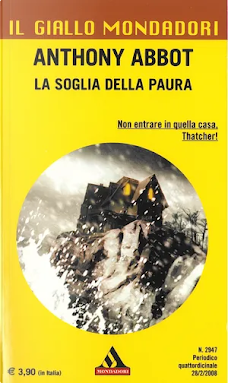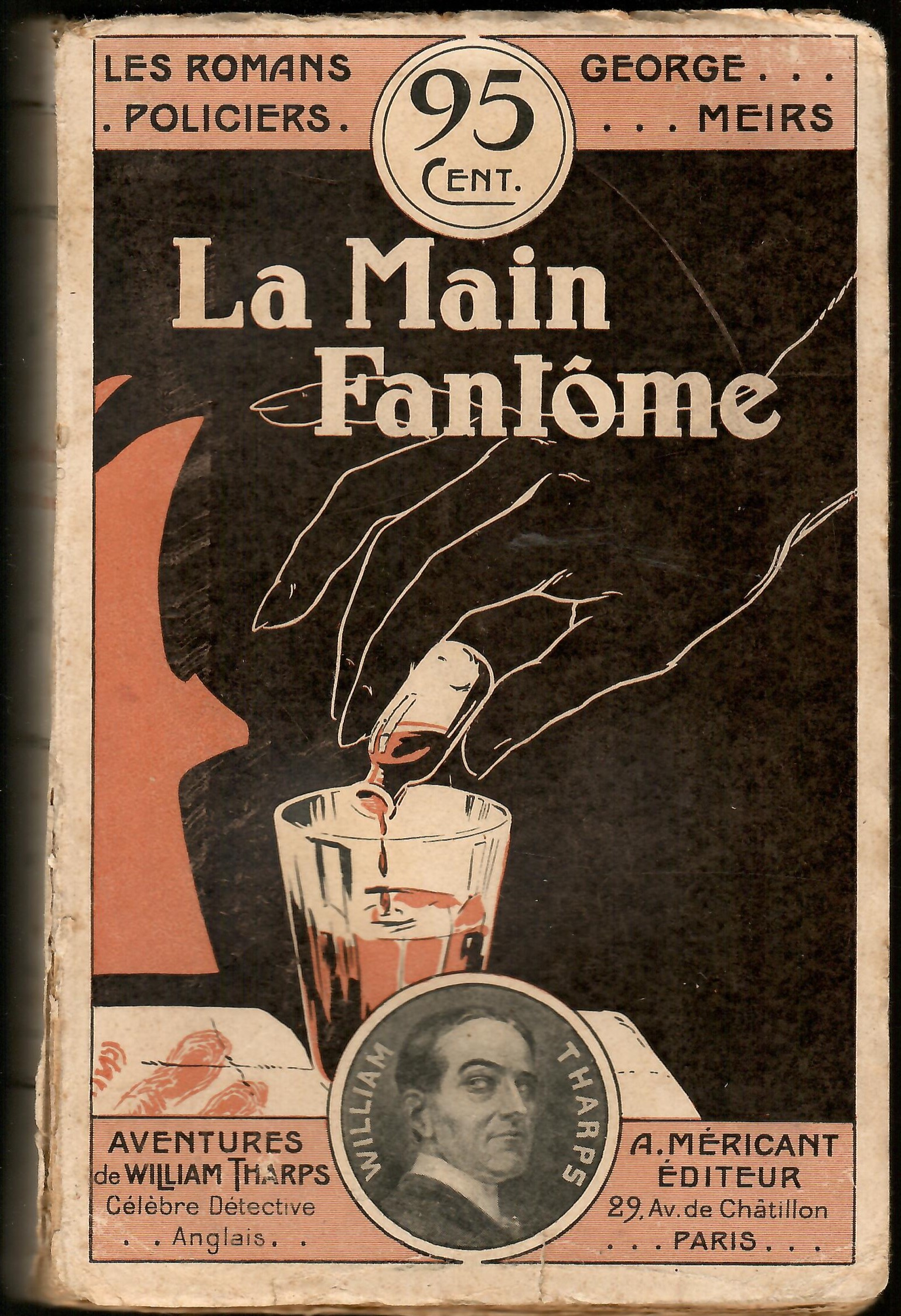After a long time, we return to review a novel by Anthony Abbot. In this case of the eight novels he published, this is the penultimate.
The Creeps, original title, written in 1938, was published in 1939. It is a novel with a great atmosphere, which seems to be different from the other six first novels.
WARNING: SPOILERS !!!
Thatcher Colt is no longer Chief of the NYPD. He retired to private life and got married. His wife Florence thinks that he is bored without being able to dedicate himself to solving some good case, and so she does everything to get them to agree to go to his relatives in Denmouth. Fortescue Baxter's son, Terry, is to get married the following Sunday to his father's secretary, Evelyn Drew, and so the two Colts plan to have fun and have fun: Thatcher is above all attracted by the idea of meeting the famous Swiss parapsychologist, Doctor Adolf W. De Selles, who will be present to whom Fortescue Baxter, former friend of Thatcher, intends to leave a million dollars for his studies. Thatcher and his wife will be accompanied by their friends, Abbot and his wife Betty.
And it is precisely in the train carriage that is taking them to Denmouth that Thatcher and Anthony and their wives meet De Selles. When they arrive, the landscape is covered in snow. Randall, the Baxter's driver, should be waiting for them to take them to their destination, but there is no trace of him. So, a guy with an old grinder agrees to take them to their destination and they go up towards the property which is on the cliff, under which the sea boils. Everything is covered in snow. In the garden, De Selles looks at someone who seems to be staring at him from a tree, and mutters about something he says is wrong with that house.
Guests are introduced to the host, son and relatives. We immediately notice how most of them are hostile to the old man giving up a substantial part of the inheritance to someone who according to them is an old charlatan: there is Fortecue's sister, Eunice; the future bride; Margaret Dixon, black journalist, acquaintance of Thatcher; Charlie Adams, another cousin, a famous explorer, has just returned after many years spent in Siam and his wife Ursula, who by chance (but nothing is by chance) is also joined by Terry's ex-girlfriend, Mary Stevens.
It is the eve of Thanksgiving Day, November 23rd. The evening passes peacefully or almost as Adams and Eunice and then Margaret who seemed to have gotten lost in the snowstorm and who instead appears, ask that De Selles show his peculiarities, that is, prove that he is a parapsychologist: How? With a séance. De Selles reluctantly accepts: the medium will be Drew who, with De Selles, reveals to have a certain predisposition for these practices. During the session, Drew is possessed by the spirit of Baxter's ex-wife, Gertrude, who accuses someone of having killed her and of having hidden her bones in that house without giving her a Christian burial.
Forterscue Baxter leaves destroyed by the revelation, which would seem to accuse him. Terry looks at his father in horror, and the germ of fear and suspicion creeps into the house. during the night, the girl Evelyn who fell into a trance is found dead in Charlie Adams' bed. What appears to have been an affair that ended badly ends up being seen with a different eye: the girl was chloroformed to death by someone and then the dying girl, looking for help, looked for it in Adams who was snoring on his own for the drunk in the evening, dying in his bed.
After Gertrude's bones and Randall's body are found, the driver who was supposed to take Thatcher Colt and Anthony Abbot and their wives to his estate, Colt assisted by Abbot, called to investigate by the local sheriff in the Baxter estate isolated by the snow, she will pin the diabolical murderer to his responsibilities.
THE END OF THE SPOILERS
A beautiful novel by Abbot, it stands out for its somewhat convoluted style, compared to the previous six, and for a great atmosphere. Some critics overseas (John M. Nevins, the major critic of Ellery Queen, and my acquaintance Mike Grost, author of a history of online detection that would have deserved some recognition) are inclined towards attributing the novel to a ghost writer, instead that to Abbot, due to the slightly different style from the other previous ones, and also due to the abandonment of the identical construction of the title (About + the Murder + Subject) which is characteristic of Van Dine's period since, despite some differences, they use it both Van Dine what a Queen. However, several factors are not taken into account:
first of all, that the previous ones were all anchored, plus the first ones and gradually the rest, to a detection very close to van Dine's style from which they derive; Bear in mind that Abbot's last Vandinian novel, About the Murder of a Man Afraid of Women, dates back to 1937, and Van Dine was still making novels then (The Kidnap Murder Case was written in 1936) but shortly thereafter he would write his last two that show clear signs of weakness and involution (The Gracie Allen Murder Case of 1938 and The Winter Murder Case of 1939). Again in the 1937 novel, Abbot dwells on a series of scientific police and ballistics findings, which are also found in Van Dine's novels, for example The Benson Murder Case. But from The Creeps, everything changes: it is true that Thatcher Colt is no longer a member of the police and therefore in the investigation, an illustration of police procedural techniques would be out of place, and therefore the characteristic of the six previous novels no longer exists which all have a combination of Van Dine detection and Procedural, but it is also true that Abbot, precisely due to the involution of van Dine's stories and his loss of popularity and the affirmation of other novelists, tends to try new paths, rather than refer to Van Dine. Now Thatcher Colt is a well-rounded detective, and with The Creeps, the references in Abbot are to other novelists of his time, first and foremost Ellery Queen. In fact, I detect marked similarities between this novel by Abbot and one by Queen, The Twin Syamese Mystery: there is a house perched on a hill, like here; Ellery replaces the police in carrying out the investigations, and Thatcher Colt does the same thing here, despite no longer having any position in the police; there the house is isolated from the rest of the world by fire, while here it is isolated by snow; there crimes occur within a family, as here: and here as in that case, a scientist is present.
Saying that the novel can be ascribed to a ghost writer, just because you can't find the same way of writing and illustrating the facts as in other works, is a bit risky for me, if you don't take into account a series of other factors. Furthermore, Abbot's tendency to lead a crusade against the boasters and charlatans of the paranormal recurs in this novel: here he is aimed at revealing the false nature of De Selles, revealing the falsity of the construction of the séance; in About the Murder of a Startled Lady (1935), the medium's trance implant is exposed, with a hidden radio implant connected to the medium's apartment being found in the next room. And moreover Fulton Oursler in 1930, under the pseudonym of Samri Frikell, had written the book Spirit Mediums Exposed, in which he declared “I am the foe of fakery, of charlatanism, of hoodwinkers, of wonder-mongers, of miracle pretenders — of BUNK. And of all the low-down creatures in the world, the religious faker, the scoundrel that pretends to trusting and ignorant people that he can bring them face to face and voice to voice with their beloved dead, is the most contemptible.”
His Autobiography, begun in 1949 and published posthumously in the sixties by his son Ousler Jr., also reiterates Fulton Oursler's paternity of his works, which clearly says (page 361 of Behold this Dreamer!): At the same time Fulton kept up his parallel careers. Between 1938 and 1941 he completed two more Anthony Abbot novels (The Creeps and The Shudders) and one short story, “About the Perfect Crime of Mr. Digberry,” which was published in the first issue of Ellery Queen's Mystery Magazine and later made into to movie.
There are many other references to previous novels in the novel: for example. the note on the elegance of Thatcher Colt. In this regard, in Fulton Ousler's biography, we read (page 256): The hero of these detective tales, incidentally, was one Thatcher Colt, the police commissioner of the City of New York. In my mind he was a combination of two men: Grover Whalen and Theodore Roosevelt — the one an impeccable dresser, the other blessed with real brains.
However, although there are very original ideas in the solution of the three crimes, the murderer, despite being present in the story from the beginning, is identified on the basis of clues that appear clear only to Colt, but of which the reader is not precisely informed . Furthermore, as Curtis Evans insinuates, how does the son know where his mother was buried? There are some passages that are not very polished, weak. In the fake message from the mother's spirit, it says more or less "you must bury me Christianly.. it is not right that she is buried like this.. here, my bones are in this house..". Now, if the message had been true, the continuation of the actions, especially the discovery of the bones by his son Terry, would have made sense. But if the message is false, that is, it does not come from Gertrude's spirit, but is the result of a plot carried out by two people, and the words are invented, how does Terry find his mother's bones right in the house? It is a pure coincidence, because the body could have been buried elsewhere, taking into account that when the crime occurred, there was no one in the house except the victim and the murderer, and the estate was one hundred and twenty hectares in size.
This means that the story, despite being original, even if influenced by Ellery Queen and perhaps also by Anthony Berkeley (Murder in the Basement, 1932) or rather by another Vandinian like Stuart Palmer (Murder on the Blackboard, 1932), is more weak in the plot of the other previous novels by Anthony Abbot, even if it has a great atmosphere, and even if the reading is very pleasant and the solution manages to convince. Perhaps this is why Abbot, in retrospect, having ended his period as a writer of detective novels in 1941 with The Shudders, recognized only the six previous novels as public successes, despite having published the other two, again with Macfadden Publications (with whom he published continuously from 1921 to 1941). Moreover, we also have other examples of authors who, very original and appreciated by the public in their first novels - I am thinking for example of Rufus King - over the years, and the loss of their own examples (Van Dine), looking for references in other writers (e.g. Rex Stout) lost their originality and their impact on the public.
Pietro De Palma





